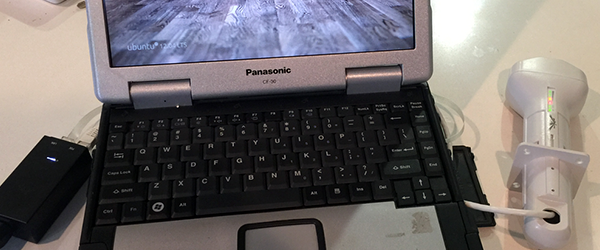I went to the Opening Ceremonies of DEF CON 23 this morning to get more information on the badge challenge and I was not disappointed. The talk covered the Uber badge, which is hot in a literally radioactive sense. This badge, which is also known as the black badge, is reserved for people who are first to solve one of the official DEF CON challenges. It grants lifetime free admission and opens just about any door when listed on your resume.
Lichtenberg Figures
The triangle of acrylic itself is adorned with Lichtenberg Figures. This is a bolt of lightning on the badge. By building up extremely high voltages, the discharge leaves a unique pattern. In this case it was a 5 million volt, 150 kW particle accelerator that made the figures.
There is a medallion affixed to this triangular base-plate which is obviously part of the puzzle everyone is trying to solve this weekend. What is less clear is how the radioactive isotopes of this badge play into this challenge.
Whoa, oh, oh, oh, I’m Radioactive, Radioactive

[LoST] took inspiration from [Richard Feynman] to a new level with this badge. [Feynman] was involved with “The Gadget” experiment which I know better as Trinity, the first detonation of a nuclear weapon. This badge contains isotopes from that detonation.
Trinitite (get it, from the Trinity explosion?) is a green glassy substance generated from a Plutonium-based bomb explosion. [LoST] made a point of explaining that the samples of Trinitite in this badge create a unique radioactive signature that not only traces back to this explosion, but actually indicates a precise distance form the epicenter of the explosion.
Also embedded in the badge are glass spheres doped with 3% Uranium 238. Tritium, used in exit signs, is a third source of radioactivity on the badge. This is joined by another marker that is a combination of Uraninite, Pitchblende, Carnotite, Gummit, and Yellowcake.
Interesting story, Tritium is highly regulated in this country but it is hypothetically possible to import it from Europe by a seller who ships it sealed inside packets of coffee. Hypothetically.
The opening ceremonies talk concluded with some inspirational remarks from [Dark Tangent]. Pictures of that as well as a few of [L0ST’s] slides are found below. If you’re working on the badge challenge, join in on the collaborative Badge deciphering we’ve started on Hackaday.io. If you’re at DEF CON, make sure to show up for breakfast with us on Sunday.
Continue reading “DEF CON Uber Badge So Hot It’s Radioactive”





 If you’re in town Sunday morning, come nurse your hangover with [Brian], [Eric], and me. We’re headed to Va Bene Caffè at 10:30am on 8/9/15. It’s just across the street in the Cosmopolitan.
If you’re in town Sunday morning, come nurse your hangover with [Brian], [Eric], and me. We’re headed to Va Bene Caffè at 10:30am on 8/9/15. It’s just across the street in the Cosmopolitan. 




















